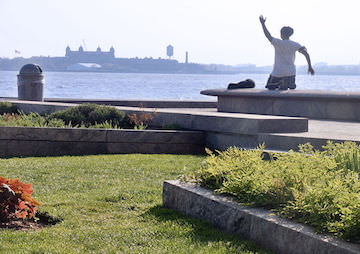Greener Cities Are Best at Taming Urban Heat
Researchers find evidence that cities with more green space are best for human well-being.
By Tim Radford, Climate News Network

Manhattan’s Battery Park gives New Yorkers space to work out. (Jorge Royan via Wikimedia Commons)
This Creative Commons-licensed piece first appeared at Climate News Network.
LONDON — For the first time in human history, more than half the world now lives in cities. Later this century, the proportion could rise to two-thirds.
Even without global warming because of a build-up of carbon dioxide in the atmosphere, itself the consequence of fossil fuel combustion, the cities are feeling the heat.
That is because dark materials and hard surfaces — tarmacadam, brick, cement, tiles, slates, gutters, railway tracks, flyovers, motorways and so on — absorb the heat but not the rainwater that, as it evaporates, could damp down that heat.
As a consequence, cities become “heat islands”: places conspicuously hotter than the surrounding countryside. According to a report in Nature, the annual average temperature in Los Angeles in California has risen by more than 2°C since 1878, and by mid-century the sprawling megalopolis is predicted to face 22 days a year of extreme heat: that is, with temperatures of more than 35°C.
Now British and US scientists are trying to work out the shape of the ideal city. Pack people together with lots of green spaces around, say the British. And keep the people cool with trees, parks, roof gardens to help them withstand the heat, add the Americans.
Researchers at the University of Exeter in the UK and the University of Hokkaido in Japan report in the journal Frontiers in Ecology and Environment that they analysed nine case studies of cities worldwide to work out the arrangements with most benefits to humans.
Dense but spacious
The answer — separate from the climate question — is that dense settlements but with big parks and nature reserves deliver the greatest sense of well-being and the healthiest urban ecosystems.
“As populations continue to grow, it’s vital that we expand our cities and build new ones in a way that is most sustainable for ecosystems, and which provides the greatest benefits to urban residents”, said the lead author, Iain Stott, from the University of Exeter’s Environment and Sustainability Institute on the Penryn campus in Cornwall.
“Our research finds that compact developments that include large green spaces are essential for the delivery of ecosystem services. For humans to get the most benefit, however, combining this approach with greening of built land using street trees and some small parks and gardens is the best method.”
Rather than focus on selected cities, a team led by scientists from the US space agency NASA report in Environmental Research Letters that they took an overall look at what asphalt and concrete do to the whole United States.
The satellite data told a familiar story: those tracts of America covered by impervious surfaces such as roads, pavements, roofs and car parks were in summer up to 1.9°C warmer than the surrounding rural zones, and in winter 1.5°C.
“Urbanisation is a good thing…but we could probably do it a little bit better”
“This has nothing to do with greenhouse gas emissions. It’s in addition to the greenhouse gas effect. This is the land use component only”, said Lahouari Bounoua, of Nasa’s Goddard Space Flight Centre in Greenbelt, Maryland, and lead author. “Anywhere in the US small cities generate less heat than mega-cities.”
Green things cool by evapo-transpiration. Broadleaf trees with big leaf areas can cool cities more than forests of pines with fine needles. The message is that green is good for cities and cities are good for the environment.
Cities in arid places — Phoenix in Arizona is a case in point — can paradoxically be cooler than the surrounding desert because residents bring lawns that must be watered, and trees for shade.
This creates another problem. Water is a scarce resource and rising urban temperatures could make it even scarcer. Researchers from the University of Florida report in the journal Technology and Innovation that a survey of homeowners in Orange County, Florida, found that 64% of drinking water went to irrigate the lawns. In summer this proportion went up to 88%.
Whatever the urban problems, global warming and climate change will make them worse, but cities offer ways to reduce energy use and save carbon dioxide emissions.
“Urbanisation is a good thing”, Dr Bounoua said. “It brings a lot of people together in a small area. Share the road, share the work, share the building. But we could probably do it a little bit better.”
Your support matters…Independent journalism is under threat and overshadowed by heavily funded mainstream media.
You can help level the playing field. Become a member.
Your tax-deductible contribution keeps us digging beneath the headlines to give you thought-provoking, investigative reporting and analysis that unearths what's really happening- without compromise.
Give today to support our courageous, independent journalists.






You need to be a supporter to comment.
There are currently no responses to this article.
Be the first to respond.